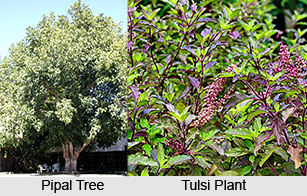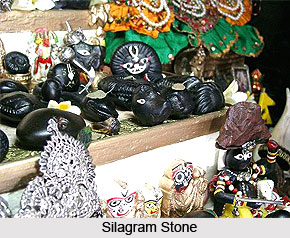 Marriage with trees, plants and inanimate objects are quite common instances in the ancient Hindu society. Tulsi and Pipal tree are the most common bridegrooms in Hindu culture. Hindus do not believe the marriage ceremony to be merely a nuptial tie between men and women. In earlier days, it was not often carried out, considering the trees, plants and many inanimate objects, this ritual was particularly carried out among the Vaisnuites. Tuhi or holy basil with the botanical name as Ocymum sanctum is not just holy to Vishnu or to his companion Laksmi, but it is passed through by the spirit of these deities and itself worshipped as a deity of Sita, wife of Rama or Vishnu`s incarnation.
Marriage with trees, plants and inanimate objects are quite common instances in the ancient Hindu society. Tulsi and Pipal tree are the most common bridegrooms in Hindu culture. Hindus do not believe the marriage ceremony to be merely a nuptial tie between men and women. In earlier days, it was not often carried out, considering the trees, plants and many inanimate objects, this ritual was particularly carried out among the Vaisnuites. Tuhi or holy basil with the botanical name as Ocymum sanctum is not just holy to Vishnu or to his companion Laksmi, but it is passed through by the spirit of these deities and itself worshipped as a deity of Sita, wife of Rama or Vishnu`s incarnation.
Among any other plants, Tulsi is adored by most of the Hindu families. Tulsi is still the object of more admiration than any other plant presently, worshipped in India. The rosaries of Tulsi beads are sometimes religiously, or sometimes fashionably worn by Vaisnuites. According to H.A. Rose, from his book of Religious Life of Indian People, when a wealthy Hindu do not have a son, he will get a Brahmin married to a Tulsi plant for the fulfillment of his wishes. This is regarded as a fairy metamorphosed by Lord Krisna. The ceremonies are honored in full and are quite expensive. The Tulsi is then formally given to the Brahmin, who is thought to be the donor`s son in law for the rest of his life, because he has traditionally married his bride by his fictitious father in law.
In the western part of India, an idol of young K`rsna is often displayed in the parade from the house of one of the Vallabhacharyas, to some wealthy man`s residence, where the Tulsi is kept. This idol is placed in a gorgeous "palki" and followed by a long train of disciples. Then the marriage parties are celebrated with great pomp and show at the cost of probably, several thousand of rupees.
In some other parts of the country, the Tulsi is even married to the black Salagram pebble. This tree resembles black pebble and represents Visnu or K`rsna. It is believed that the God is present in the stone, even without sanctification. The pebble bridegroom is positioned on the leading elephant or at times horse and the marriage party carry on to the patron of the Tulsi plant. It is customary to maintain the imaginary matrimonial relation between Tulsi and Krisna, by resting a leaf of the Tulsi plant on the Salagram stone.

In Hindu weddings and other religious ceremonies, trees play important roles in the rituals. There is a social superiority among the trees; Pipal is the holy fig tree and is called Ficus religiosa botanically. This tree is regarded as the Brahmin among all trees. The Pipal tree has a divine character of its own. This tree has the essence of the God Brahma, Vis`nu and Shiva. However, Vis`nu in his K`rsna manifestation has the greatest influence on this tree.
In the Bhagvad Gita, a famous quote by Krisna is: "I am Asvattha (Pipal) among the trees. It is believed that spirits delight to sit on the branches of these trees and listen to the rustling of the leaves." This tree is sometimes adorned with a sacred thread, and thought as to be Lord Brahma, most of the Hindus ceremonies and rituals of investiture are performed over it. The mysterious rustling of the quavering leaves, resembles those of the poplar tree and is one cause of the superstitious wonder, due to which the tree is respected.
No Indian native can dare to cut or injure this Pipal tree. The Indians never even tries to interfere with the growth of this tree. Marriage of young girls to this tree was done with the idea that the dangers of a second marriage can be passed on to this particular tree or any other trees. Anothr idea that prevailed among the Hindus was that such type of marriages was to ensure that the girl would absorb some of its fertility, of the tree.
Among the Gauras in Orissa, tree marriage appears in its cruelest form. The girl who is supposed to get married to the tree is taken to the forest and fastened up to a tree. The risk of being eaten up by the wild beasts is at its most and the first comer is tied to the best tree in the locality. Some youngster of the other tribes of inferior branchs arranges this ritual. But the girl is usually not married to this young man of the other tribe, rather she is carried her away by some other tribe when her people had abandoned her.
Proxy marriages are also performed with the trees sometimes. The Holkar of Indore send his sword tied with a handkerchief to the bride`s house, in the hands of a shepherd. The marriage was made official with the maharaja. The Hindu texts show too many instances of marriages being held with the tree. One instance shows that a bridegroom, who was very ugly, but in love with a girl and vice versa, send across his Sitar or a string instrument to the bride`s house, which she accepted and came to him as a bride. These unusual types of marriages were very common in the past, but are no longer in practice.
More on Indian Marriage Customs
More on Indian Wedding Accessories
More on Indian Religious Weddings
More on Types of Marriages
See also
 Marriage with trees, plants and inanimate objects are quite common instances in the ancient Hindu society. Tulsi and Pipal tree are the most common bridegrooms in Hindu culture. Hindus do not believe the marriage ceremony to be merely a nuptial tie between men and women. In earlier days, it was not often carried out, considering the trees, plants and many inanimate objects, this ritual was particularly carried out among the Vaisnuites. Tuhi or holy basil with the botanical name as Ocymum sanctum is not just holy to Vishnu or to his companion Laksmi, but it is passed through by the spirit of these deities and itself worshipped as a deity of Sita, wife of Rama or Vishnu`s incarnation.
Marriage with trees, plants and inanimate objects are quite common instances in the ancient Hindu society. Tulsi and Pipal tree are the most common bridegrooms in Hindu culture. Hindus do not believe the marriage ceremony to be merely a nuptial tie between men and women. In earlier days, it was not often carried out, considering the trees, plants and many inanimate objects, this ritual was particularly carried out among the Vaisnuites. Tuhi or holy basil with the botanical name as Ocymum sanctum is not just holy to Vishnu or to his companion Laksmi, but it is passed through by the spirit of these deities and itself worshipped as a deity of Sita, wife of Rama or Vishnu`s incarnation.


















